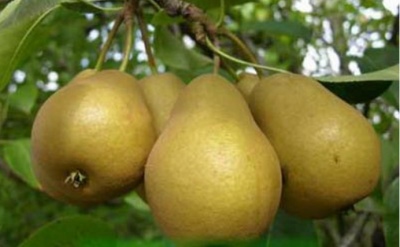
- Authors: Petrov Yu.A., Efimova N.V. (Federal State Budgetary Scientific Institution of the Federal Research Center of Horticulture)
- Appeared when crossing: obtained from pollination of interspecific hybrid No. 9 with a mixture of pollen from southern varieties
- Year of approval: 2001
- Fruit weight, g: 70
- Ripening terms: autumn
- Fruit picking time: September 15-25
- Appointment: fresh
- Growth type: medium height
- Height, m: 5 to 7
- Crown: rounded
It is difficult to find a more widespread crop than the pear, the adaptive potential of which allows it to be grown in almost all corners of Russia. The fruits contain many biologically active substances that determine their medicinal properties. Intensive development of horticulture is impossible without further improvement of the varietal composition, therefore breeders are constantly introducing new highly productive varieties, one of which is Thumbelina.
History of creation
The variety was bred relatively recently, in the 1990s, by breeders Petrov and Efremov at the Federal State Budgetary Scientific Institution of the Federal Research Center of Horticulture based on the results of crossing several southern varieties with interspecific hybrid No. 9. The plant got its name for a reason. The size of the pear and the tree itself is small compared to other species grown in the European part of Russia.
Description of the variety
The tree reaches a height of 5-7 meters. Its crown is relatively thin, its shape is rounded. The branches of the tree branch off from the trunk at an angle of 90 degrees, the color of the branches is brown, the shoots are even. Thumbelina's foliage is glossy, slightly pointed at the edge, elongated. The flowers are small, white. The buds are in the shape of a cylinder, brownish-brown in color, while they are slightly deviated from the branch itself.
Fruit characteristics
The fruit fully lives up to its name. The pear is very small, symmetrical, the normal weight is 70 grams. The shade is amber, there are numerous freckles of a rusty shade, this is the main difference between Thumbelina. The stalk of this pear is thick, the seed chambers are closed, the seeds themselves are brown and relatively small. Under the skin there is a beige pulp with abundant juice secretion. Another characteristic feature of Thumbelina is a bright and strong aroma. In industrial gardening, the pear is valued for the fact that it does not rot for a long time, so it can be transported over long distances. Thumbelina is a frequent visitor to the store shelves in Moscow and St. Petersburg.
Taste qualities
Gardeners appreciate this variety for its extraordinary creamy-sweet, juicy taste. In all weather conditions, the pear ripens and becomes sweet.
Ripening and fruiting
This is a mid-ripening pear, the tree begins to bear fruit around the 6-7th year. The plant is resistant to various diseases, for example, fungal diseases. By ripening, the variety is autumn, but the fruits are capable of winter storage. Fruit ripening is simultaneous, but it can be picked selectively starting from the largest.

Yield
Yields are regular, albeit average. Fruits are easily separated from the branch, requiring simultaneous collection. Regardless of the weather conditions, the trees bear fruit steadily.
Landing
Thumbelina begins to be planted in spring and autumn.However, the territory of distribution of this culture covers areas where winters are cold, respectively, the plants may not survive the season, therefore planting work begins in the spring, so that the owner can follow the process of plant growth. In the warm season, it takes root well.
The seedling needs to be purchased when it is two years old, not older. There should be no damage to the bark and root system. When planting Thumbelina, you need to prepare a hole in advance with a deepening of 80x60 cm. A little sand is added to the fertile soil, then fertilizer. The root must be dipped into a hole for no more than 4 hours in a solution with water, then dig in. It is important to place the peg next to the seedling at a distance of 15 centimeters.


Growing and caring
The tree of the Thumbelina variety needs special care. After fertilizing during the planting process, it still needs to be fed regularly, first, compost is added, then mineral fertilizers. During the first flowering period, saltpeter is added, then you need to switch to superphosphate.
Saplings need to prune broken branches. Do not forget about whitewashing the trunk. Before winter, Thumbelina needs to be prepared: water abundantly, and cover the ground with sawdust. Perhaps, due to the winds, additional fixation will be needed. Although Thumbelina is practically immune to pests, in rainy times it is sometimes affected by ticks, powdery mildew. To get rid of them, you need to spray the plant with colloidal sulfur.




Like any other fruit trees, the pear needs protection from various diseases and pests. When planting a pear on your site, you need to know in advance what diseases you should beware of. To successfully carry out the struggle, it is necessary first to correctly identify the cause of the problem. It is important to distinguish signs of disease from manifestations of the presence of insects, mites, caterpillars and other types of pests.
Review overview
Thumbelina is quite popular, especially among gardeners from the middle lane. It can be grown in small areas, it is unpretentious, it is easy to grow it even for amateurs, therefore, preference is often given to it, the seedlings are not very expensive. Although Thumbelina does not like wetlands.For many years it is impossible to be left without a crop. Pear can be eaten not only fresh, it makes jam, preserves and puree very tasty. In addition, children like the miniature fruit.





































































